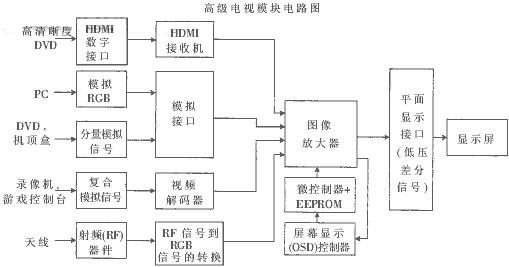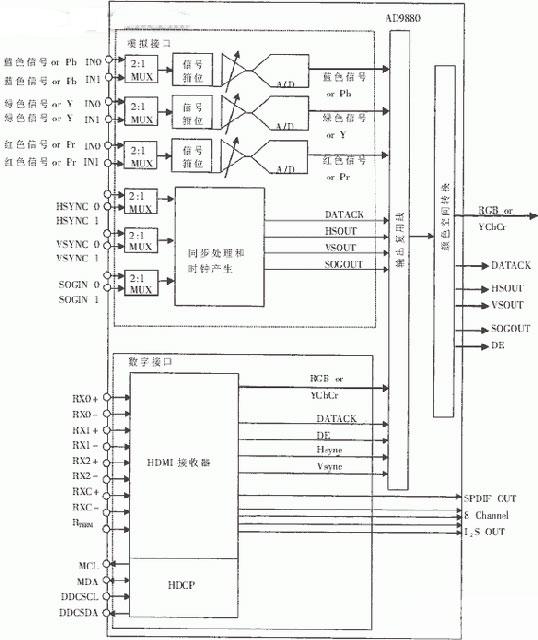Flat-panel TVs are rapidly gaining traction in the consumer electronics market, and the sales growth of this "advanced" TV is reminiscent of early personal computers (PCs). The concept of "advanced TV" now refers to LCD TVs, plasma TVs (PDP TVs), microdisplay rear projection TVs (including liquid crystal displays (LCDs), digital optical transmission processors (DLPs) and liquid crystal silicon displays (LCoS). )], front projection projector and full plane cathode ray tube (CRT) TV.
This article refers to the address: http://
To stay competitive in a fast-growing market, manufacturers can't stand still. They must work tirelessly to improve their products by reducing costs, improving image quality, enhancing reliability, and adding new user features. The most important of these is that manufacturers must increase the productivity of their products, making them easier to produce and less expensive. A key issue in achieving all of these design goals is how to use "smart integration" technology in the display interface.
Integrating discrete functions into a single chip reduces component count and lowers manufacturing costs, a strategy that has been effective for PC manufacturers over the past decade. But displays need to be "smartly integrated," because there are some major technical challenges that must be overcome when combining various display interface functions. If you want to integrate high-performance analog circuits and high-speed digital circuits into a single solution, you need to have experience in specialized mixed-signal design techniques. An integrated interface requires products that meet the requirements of low cost and small package size without sacrificing image quality and throughput.
1 Typical LCD TV
Typical LCD TVs offer a variety of options for system integration (see Figure 1), including:
The analog interface is combined with the digital interface to provide "traditional compatibility" compatible with most current DVD disc players and set-top boxes, and is "digitally prepared" for the future;
The interface is combined with the graphics controller function and the main circuitry associated with the image in the LCD TV;
Reduce the number of interconnects and simplify printed circuit board (PCB) routing to reduce signal distortion that affects image quality;
• Provide audio and PC compatibility with CD disc quality at a small cost.

Figure 1. A typical advanced TV system block diagram provides multiple options for system integration.
1.1 Integrated analog interface
While interest in emerging digital flat panel display interfaces continues to grow, component analog video interfaces remain the high quality interface of choice for advanced televisions currently on the market. Many advanced TVs also include an analog video graphics adapter (VGA) interface for compatibility with PC applications. An integrated component analog interface, such as the AD9883A from Analog Devices, Inc. (ADI), has integrated all of the traditional analog functions required for display interfaces on a single chip (see Figure 2). The first step in this display interface integration has been to reduce cost, improve image quality, and simplify PCB layout.
This integrated analog interface chip can be mass-produced using a mixed-signal complementary metal-oxide-semiconductor (CMOS) or BiCMOS wafer fabrication process and meets the requirements for flat-panel display interface applications, ie, high-speed (greater than 100 MHz) analog-to-digital converters (ADCs). ) Linear error with typical values ​​of 0.5 LSB [(Integral Linearity Error (INL) and Differential Linearity Error (DNL)]) and input bandwidth greater than 200 MHz. However, standard digital CMOS wafer fabrication processes do not provide high performance analog signal processing And the mixed signal characteristics required by the ADC.

Figure 2 Analog Devices' AD9833A integrated analog interface integrates all the traditional analog functions required for the display interface on a single chip
1.2 Adding a digital interface
The next step in display interface integration is to integrate the analog and digital interfaces on a single chip. This makes it easy to provide a traditional compatible display and is ready for future digitization. Most emerging premium TVs support component analog signal inputs for direct connection to existing DVD players and set-top box tuners. This ensures that users can use their new TV correctly.
The High Definition Multimedia Interface (HDMI) is designed for advanced TV applications. The HDMI interface provides a digital interface for high quality video (1080p resolution at 1920 x 1080 pixels) and audio with CD quality (192kHz) and 7.1 surround sound. In addition, the HDMI interface also supports High-Bandwidth Digital Content Protection Protocol (HDCP), which Hollywood filmmakers will need to protect their newly captured high-definition DVD movies from illegal copying. Advanced TVs that include an analog interface that receives component analog signals and an HDMI digital interface will give users long-term life due to improvements in their display interfaces.
1.3 AD9880 integrated interface
The AD9887 is the world's first integrated dual interface for advanced TV (see Figure 3). The analog interface is based on the AD9883A analog interface, with up to 150MHz operating bandwidth for 1080p and SXGA display resolution. The digital interface uses HDMI to provide image resolutions up to 1080p and SXGA (150 Mbps). Both interfaces share the same output signal, thus saving 48 pins compared to the two-chip analog interface and digital interface design. The chip also provides automatic detection of the interface to the display and the option of allowing the user to connect the interface on a serial data line.
The chip is available in two grades: the AD9800-100 for 720p/1080i and XGA displays, and the AD9800-150 for 1080p and SXGA displays. These two levels of choice allow TV design engineers to choose the most cost-effective solution for their displays. The AD9880 is now available in sample, complete technical literature, and evaluation board support display design engineers.

Figure 3 The world's first integrated dual interface (analog and HDMI interface) for the advanced TV AD9887, which supports resolutions up to 1080p or SXGA format with analog input and HDMI input.
1.4 Reduce internal wiring
The image quality of an advanced TV is highly dependent on the design and routing of the display interface board. One of the benefits of increasing the degree of integration of the display circuitry is to reduce the wiring between the devices, thereby improving image quality. For display manufacturers, how to interface a digital circuit with "noise" close to a noise-sensitive phase-locked loop (PLL) and ADC can still produce a satisfactory image quality interface board has encountered great challenges. . Some display manufacturing companies have spent considerable money, time, PCB and energy trying to produce a non-manufactured analog interface, but no company has succeeded. Increasing the level of integration of the interface circuitry simplifies PCB design and produces better image quality than previous discrete component PCB designs.
1.5 Relationship between image quality and integration level
The trend in LCD desktop monitors for PC applications is to integrate analog interfaces and digital image scaling into a single chip. These integrated solutions typically provide good image quality in small (15" to 17") monitors for basic PC applications such as email, web surfing or spreadsheets. But for advanced TV applications with 30" to 80" display sizes, the image quality requirements are much higher.
To provide superior image quality that meets the demands of advanced TV customers, consumer electronics manufacturers are currently designing televisions with separate interfaces and scaler chips. In many cases, industry-leading TV manufacturers are designing their own custom scaler chips to meet system requirements. Other manufacturers are choosing to use commercially available scaler chips specifically developed for advanced television. These digital scaler chips are sometimes integrated with the built-in microcontroller and EEPROM to store the display's microcode. These digital chips can be used in the latest digital circuit manufacturing processes (0.13 μm or 0.18 μm CMOS) to provide lower cost and higher performance.
2 Questions about complexity
Most of the die area consists of digital logic gates, so this integrated approach requires a 0.13μm or 0.18μm digital CMOS fabrication process to reduce cost. In some cases, embedded dynamic random access memory (DRAM) fabrication processes are used to integrate the frame buffer memory into the same chip as the image controller, but these chips are not well suited for high performance analog functions.
In order to accommodate high performance analog circuits and reduce cost, a mixed signal CMOS fabrication process is required. Because mixed-signal manufacturing processes are not commonly used, and design engineers with high-performance mixed-signal experience are still few, their analog performance is difficult to meet. As one sees the degradation of image quality in its initial integrated products, it is not as good as separate analog interfaces and digital interface products.
Although the HDMI interface is generally considered to be a digital interface, its design requires quite a lot of mixed-signal circuitry. In fact, there are more high-speed comparators in each color channel in the HDMI interface than in high-speed comparators in the ADC used in the analog interface. The HDMI standard specifies an input frequency of up to 1.6 Gbps, so achieving adequate performance requirements still requires significant capital to complete the mixed-signal design.
Using today's advanced CMOS manufacturing process, it helps to integrate mixed-signal circuits (analog interfaces and HDMI digital interfaces) into a single "interface" chip. The mixed-signal CMOS fabrication process is generally a new generation of fabrication processes that have emerged following the latest digital CMOS fabrication processes. The latest advanced CMOS fabrication process can be used by placing high speed digital circuitry on the scaler chip. This clearly illustrates the concept of "smart integration" - a two-chip solution that delivers high performance, faster time-to-market and lower total cost than an integrated single-chip solution.
3 Product Qualification Test
The integrated interface and scaler products are true mixed-signal devices that require 100% high-speed mixed-signal electrical performance testing to ensure high quality performance. The mixed-signal test solution now used for ADCs is almost as complex as the chip design itself.
Digital circuit engineers are familiar with the development of digital test programs, which are typically used to input test vectors into Automated Test Pattern Generator (ATPG) software to generate a digital test pattern. Joint scan action group (JTAG) standard boundary scan and internal scan techniques can also be employed to detect a failure rate of at least 98% in digital circuits. Existing digital logic test protocols are often used when testing these digital circuits.
But high-performance mixed-signal circuits require "high-speed" testing to verify their electrical performance. Testing high-speed analog circuits requires test code and unique test hardware from test developers to ensure accurate measurement of the signal jitter, signal-to-noise ratio (SNR), and linearity of the ADC. The high-performance mixed-signal test platform has the ability to test high-performance analog circuits in the same integrated device and high-speed, multi-pin digital circuits. Integrated interface products that have not been rigorously tested by the high performance mixed-signal test platform may have large deviations in performance from the normal distribution of the wafer manufacturing process.
Unqualified devices can cause serious problems for advanced TV manufacturers that are limited by production time and resources. For example, consider an interface product where the key parameters between different batches have a consistency deviation (failure rate is only 10%). If the supplier of the interface product cannot screen out all of these non-conforming products, the TV manufacturer using the product must perform 100% testing of its display, thus increasing the cost of its final product. Cautious design engineers are now further discovering how to test integrated interface products to ensure that only the highest quality products are available.
4 to a new level
Smart integration is key to increasing the yield of premium TV and other high image quality display products. Products are easier to manufacture because they reduce component count, improve image quality, reduce cost, and reduce size. However, the above results of reducing components will increase the complexity of integrated circuit design. Unless the integrated circuit is properly designed and fully tested, the idea of ​​increasing integration can only lead to disappointing results. Therefore, design engineers must look for components that exceed product design specifications to ensure they have reliable components that meet the new advanced TV requirements.
40Pin Ribbon Cable,Cable Ribbon,Flat Ribbon Cable,Custom Flat Ribbon Cable
Electronic Cables,Electrical Wiring Harness Co., Ltd. , http://www.nbwireharnesses.com